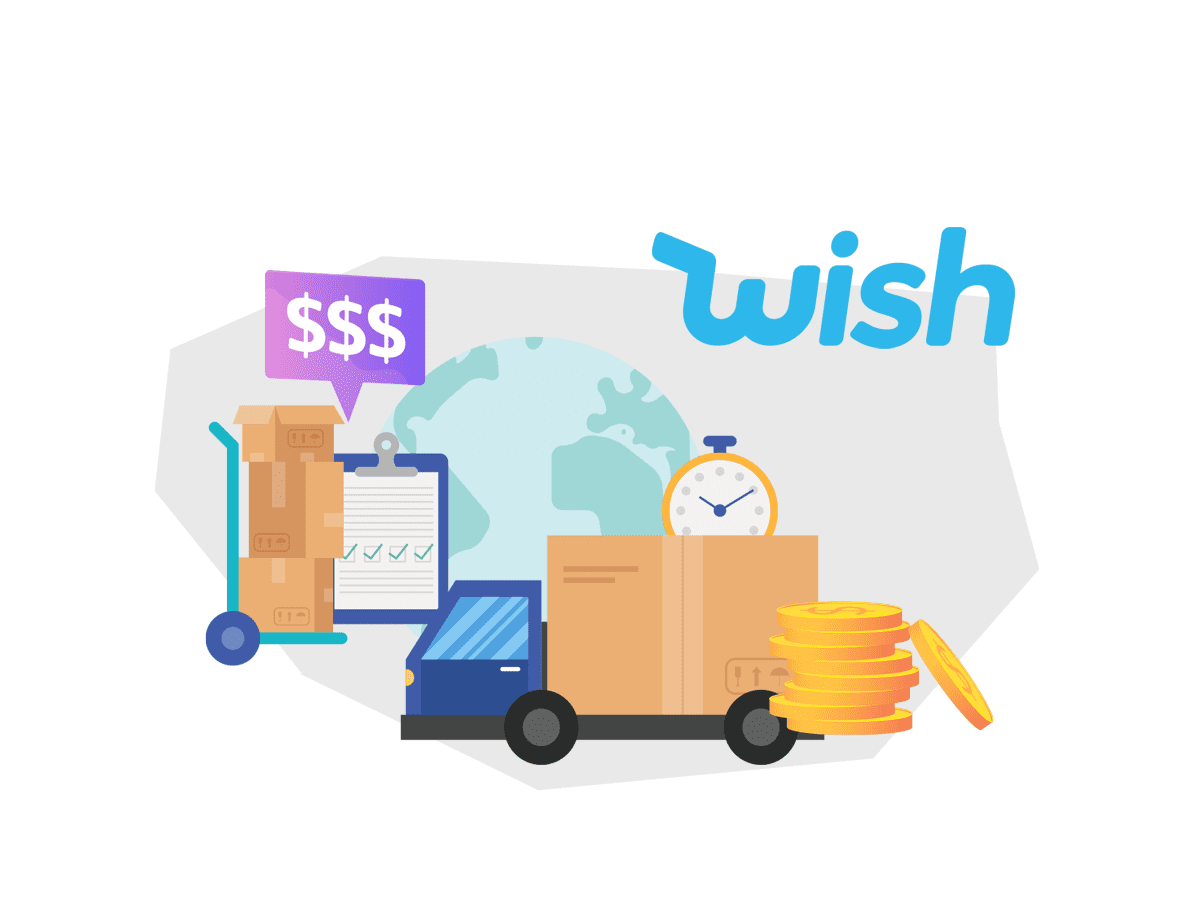
An Introduction to Wish.com: How to Sell on Wish Marketplace

Are you considering an additional sales channel for your eCommerce business? Or are you a popular retail brand looking to get started with eCommerce, and want to get your products in front of millions of customers?
If so, the Wish marketplace may be the platform for you. In this article we’ll introduce Wish.com and how it works. We’ll also break down the company’s recent changes and how they’ll affect you and your business.
What is Wish.com?
Wish is a highly popular online marketplace that primarily focuses on mobile eCommerce. Through it, third-party merchants can sell their products to the platform’s customers around the world.
The San-Francisco-based company — founded in 2010 by Peter Szulczewski and Danny Zhang — aims to sell a wide range of affordable items to consumers. The platform also provides customers a personalized and entertaining shopping experience.
Recent changes on Wish
Earlier this year, in an effort to minimize fraud and foster a trustworthy community of merchants and users, Wish transformed into an invite-only marketplace.
And, to supplement the company’s efforts to improve logistics for its sellers, Wish will be ending its Fulfillment By Wish (FBW) program on April 11, 2022. Its new emphasis will be on achieving more consistent and faster deliveries, plus improved tracking throughout the process.
Benefits of selling on the Wish app
Becoming a seller on the platform is more difficult than before, but it still has numerous perks that make it worthwhile. Plus, now that it’s invite-only, you have less competition to worry about.
Tap into its wide base of mobile shoppers
The Wish platform has 90 million monthly active users in over 60 countries around the world. The company also boasts about 1.7 million products sold daily in its marketplace.
Besides the ability to reach a huge customer base, mobile shopping is expecting to see continued growth. Statista reported that mobile commerce accounted for 5.9% of total US retail sales in 2021. It’s even projected to reach 6.9% in 2022 and climb all the way up to 10.4% in 2025.
Decrease your risk and increase your revenue
If you’re looking to implement a multi-channel approach, an additional sales channel in Wish can diversify your income streams, thus lessening your risk. If any of your earlier-established sales channels fail, a flourishing business on Wish can counteract your losses.
As for increasing revenue, Shopify reported that businesses with multiple sales channels generate 190% more than those that only use one. It makes sense: more places to buy from you means more opportunities to make a sale.
Low and convenient fees
You don’t have to worry about a monthly subscription for selling on Wish. In fact, you only have to pay a fee when you make a sale. Wish also deducts it automatically, making payments convenient for the seller.
Since the financial hit isn’t as substantial as other eCommerce platforms, joining Wish is friendly to businesses of all sizes.
Control over the Wish shopping experience
On Wish, you’re expected to provide customer service to buyers who request assistance. And, with the company’s fulfillment program ending soon, you’ll also be taking care of fulfillment shortly.
Since you’ll be responsible for packing, handling, and shipping your products, you can freely use branded materials — like custom packaging and marketing inserts — which helps your items make a strong first impression.
Plus, providing consistent and timely product deliveries and customer support can nurture loyalty from your buyers.
How to sell on Wish
Here’s a quick run-through of how to get started on Wish. Before jumping straight to your request to join the platform, however, take note of its Merchant Criteria.
Step 1: Gain access to Wish
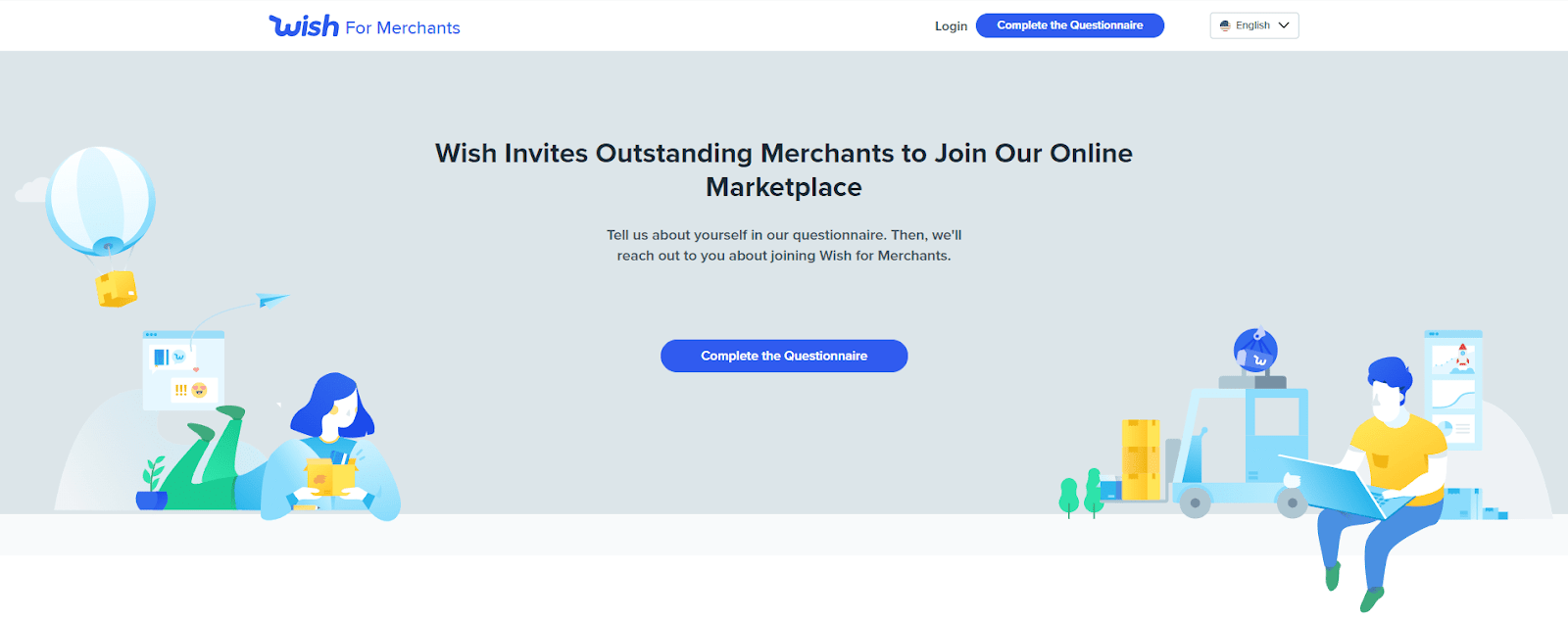
Visit the Wish for Merchants invite page, where you’ll be prompted to complete a brief questionnaire. It asks for information about you and your business, and only takes a few minutes.
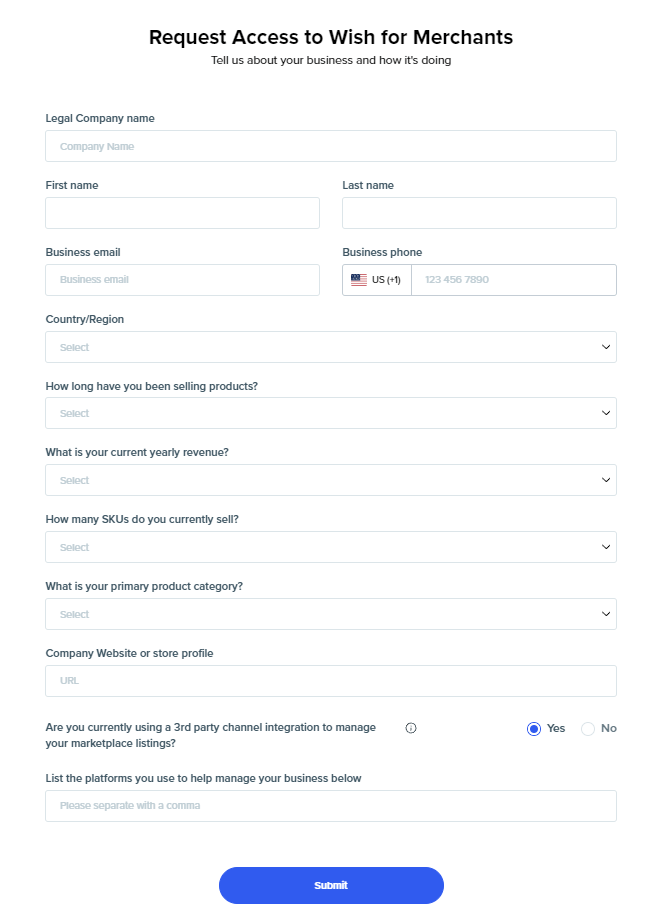
Once your questionnaire is submitted, all that’s left is to wait. Wish will evaluate your request and email you a sign-up invitation if you pass. The invite contains your personalized sign-up link, which you’ll need to finish the process.
If your application is declined, you’ll also receive an email. For any questions about the outcome or the reapplication process, you’ll have to contact Wish. Besides the aforementioned sign-up procedure, the company sometimes invites qualified merchants via outreach or strategic partnership.
Step 2: Validate your store
This is the most important step. Store validation keeps your account secure and can unlock other features. It also removes any potential limitations to your store’s sales and impressions.
Requirements
Prepare these before going through the validation process:
- Individual merchants will need to provide their government-issued ID.
- Business merchants will be asked to provide proof of identity for their business (i.e., their business registration license, articles/certificate of incorporation, or tax documents).
Validation process
Visit the Validate my store page to get started, then fill out the necessary forms.
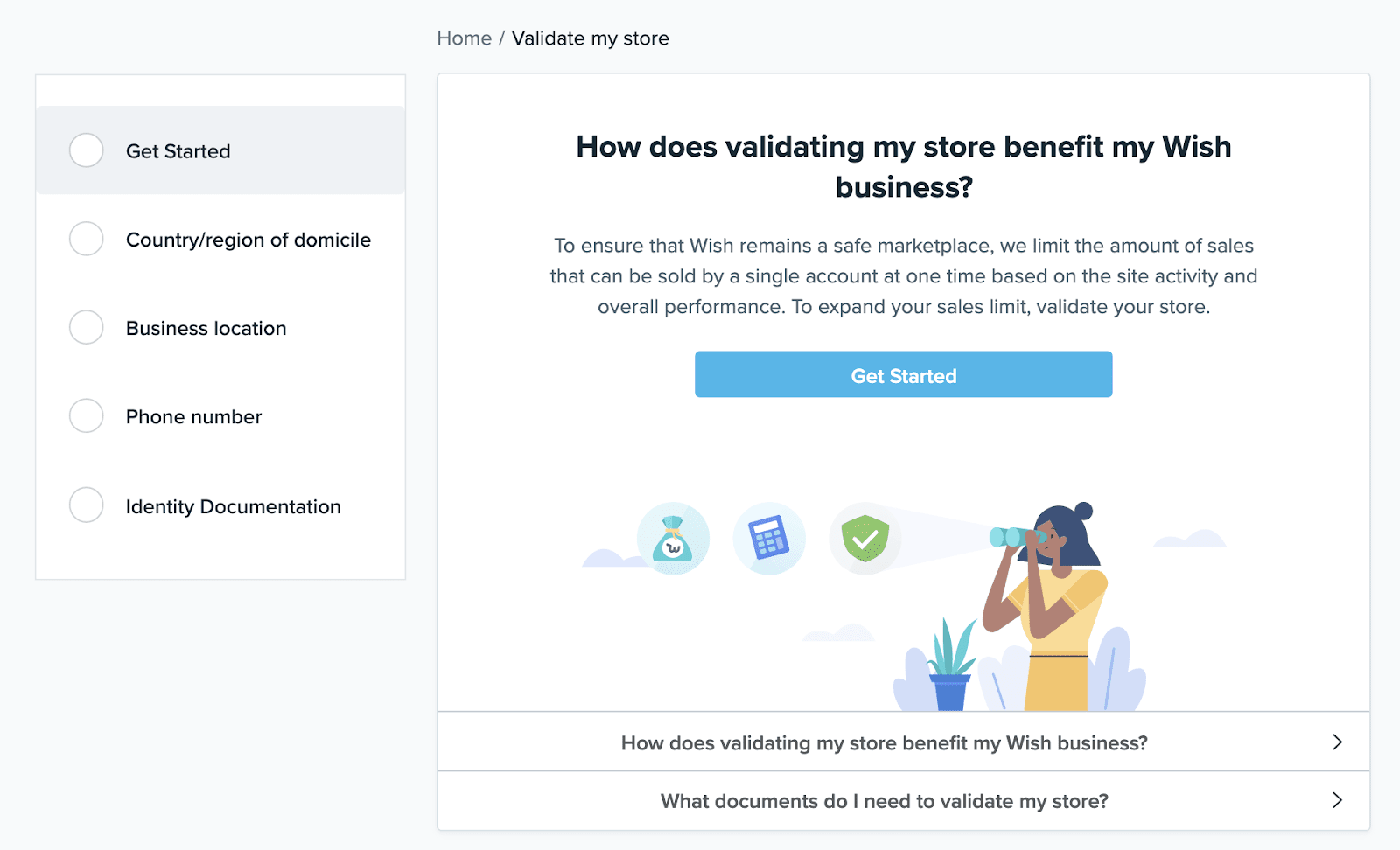
Your country/region of domicile should be:
- For individual merchants, your permanent residence or fixed legal address
- For business merchants, where the company that owns and operates your Wish store is incorporated
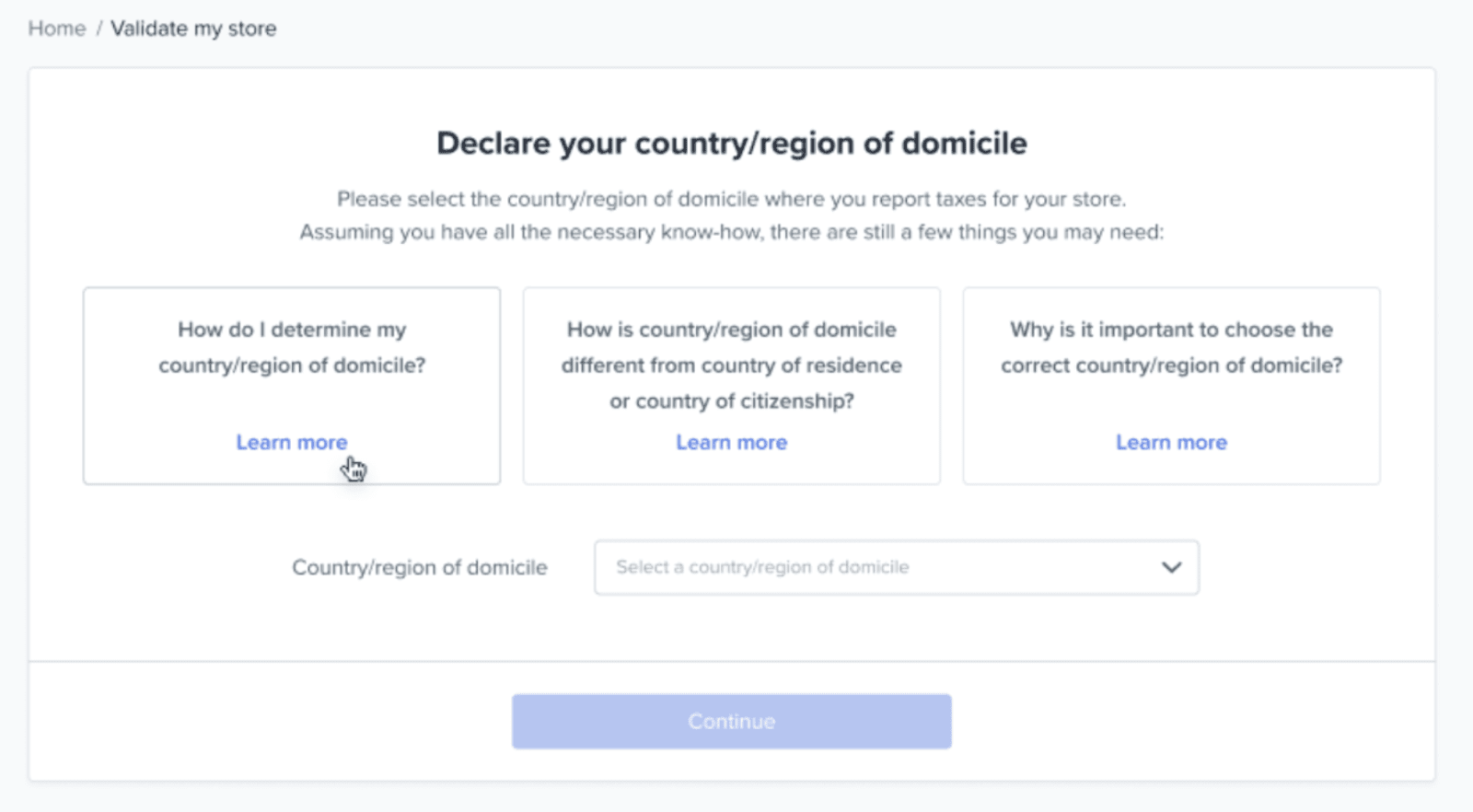
Your address should match your country/region of domicile.
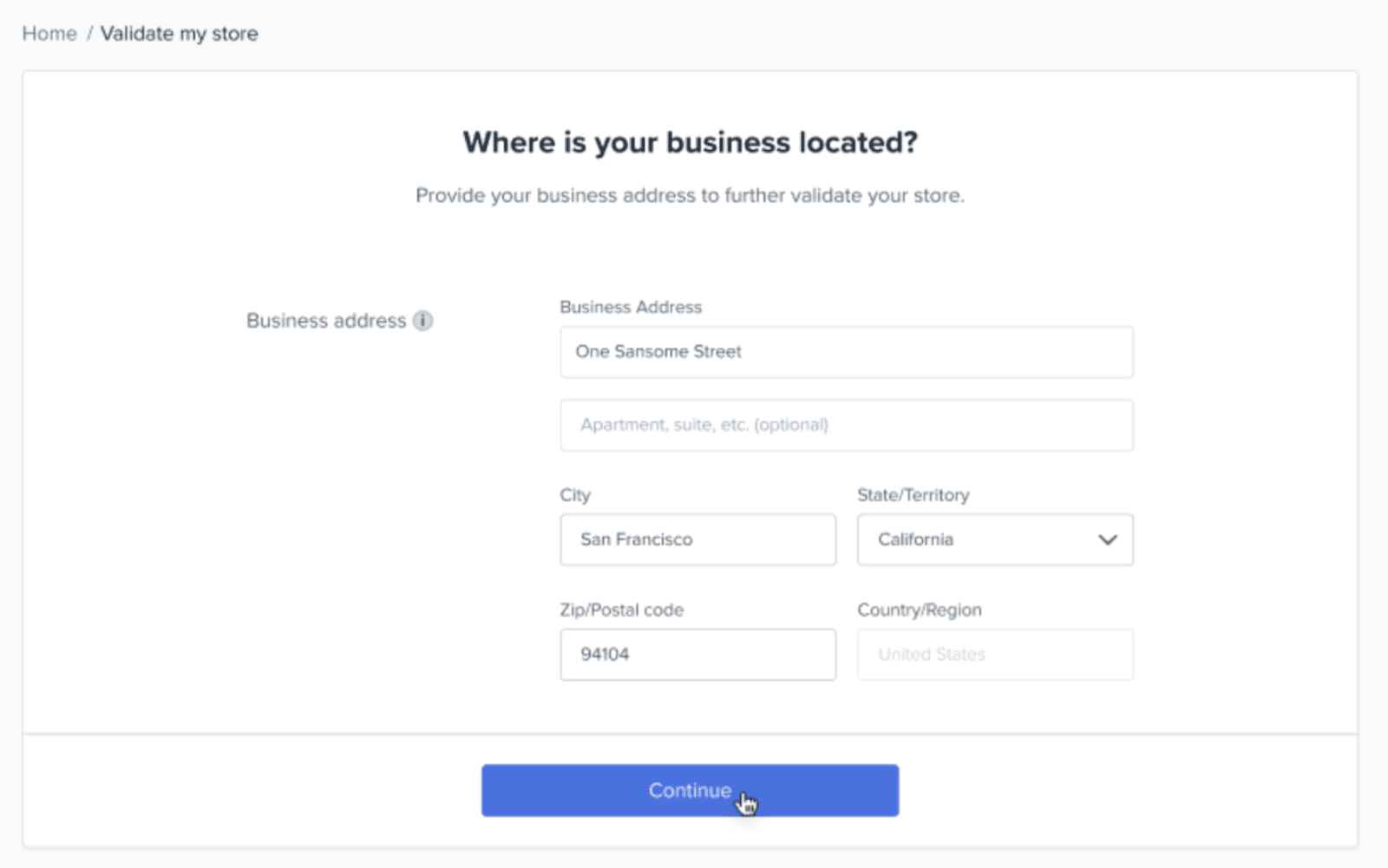
Wish will then send you a verification code via text message, which you’ll need to continue your store’s validation.

Based on your account type, provide your prepared requirements.
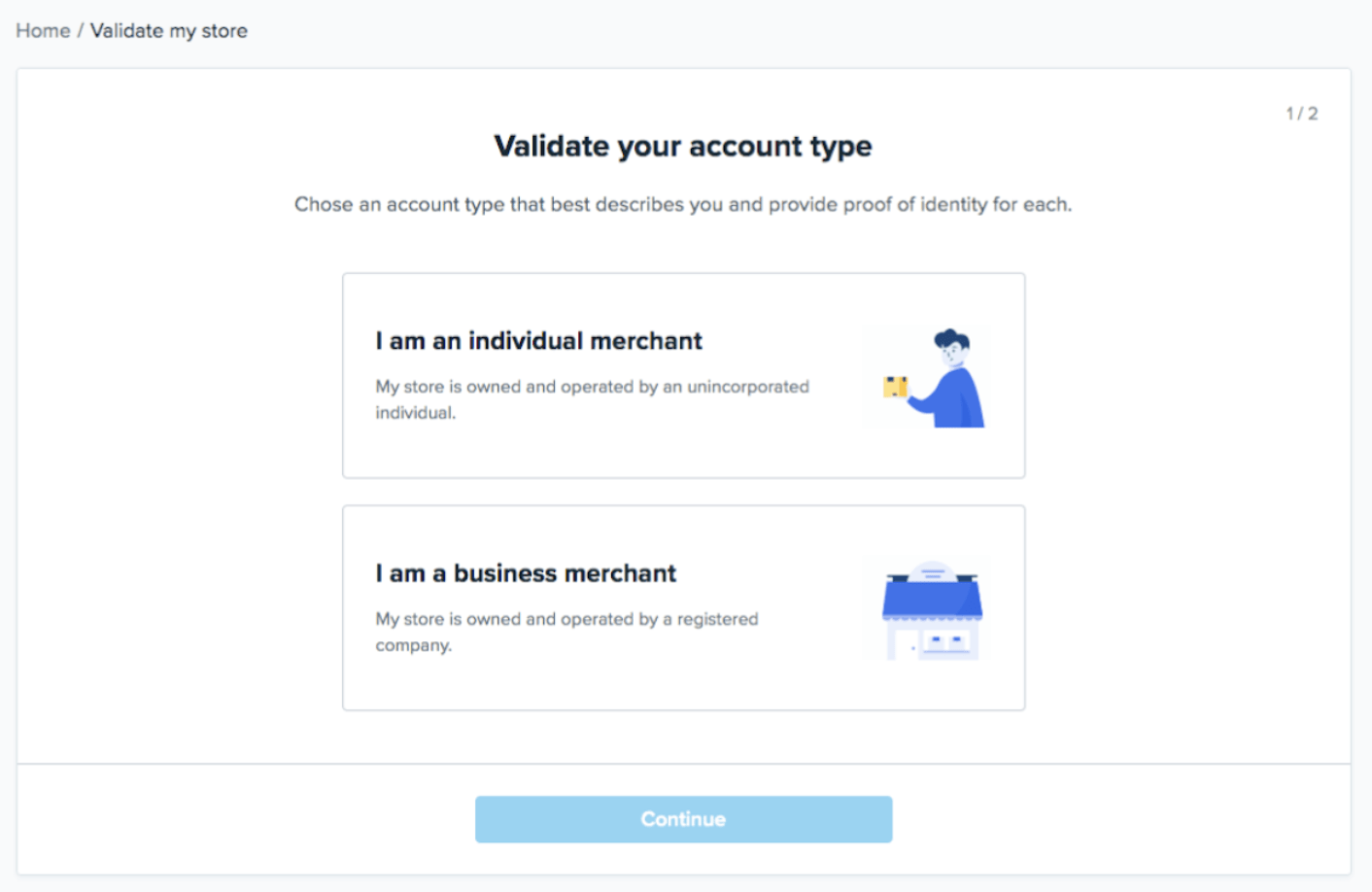
For individual merchants, make sure your ID clearly shows your full name and your country/region of domicile.
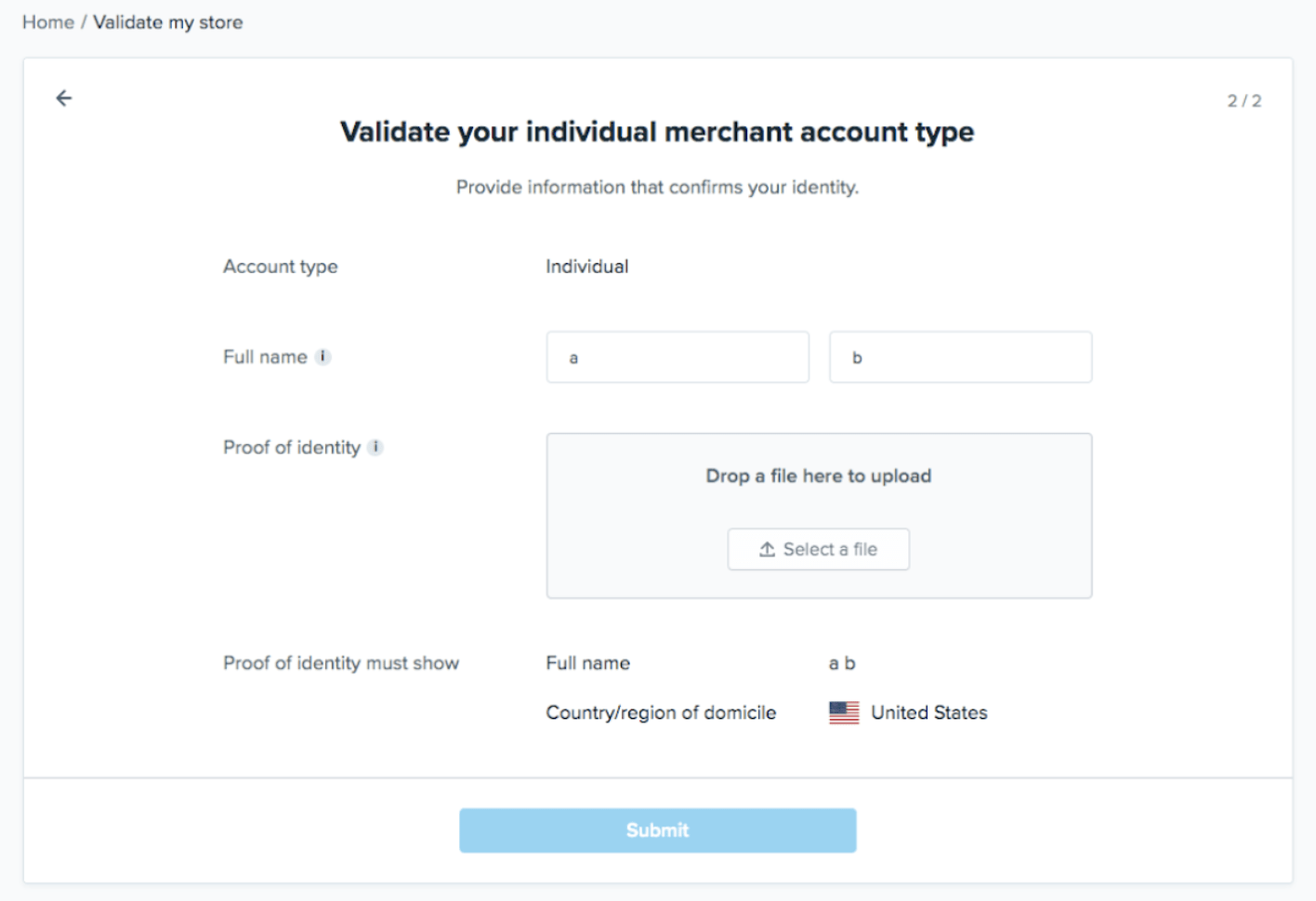
For business merchants, the primary contact person is considered the merchant account holder. They should be able to provide requirements and initiate transactions — like disbursements and refunds — on your company’s behalf.
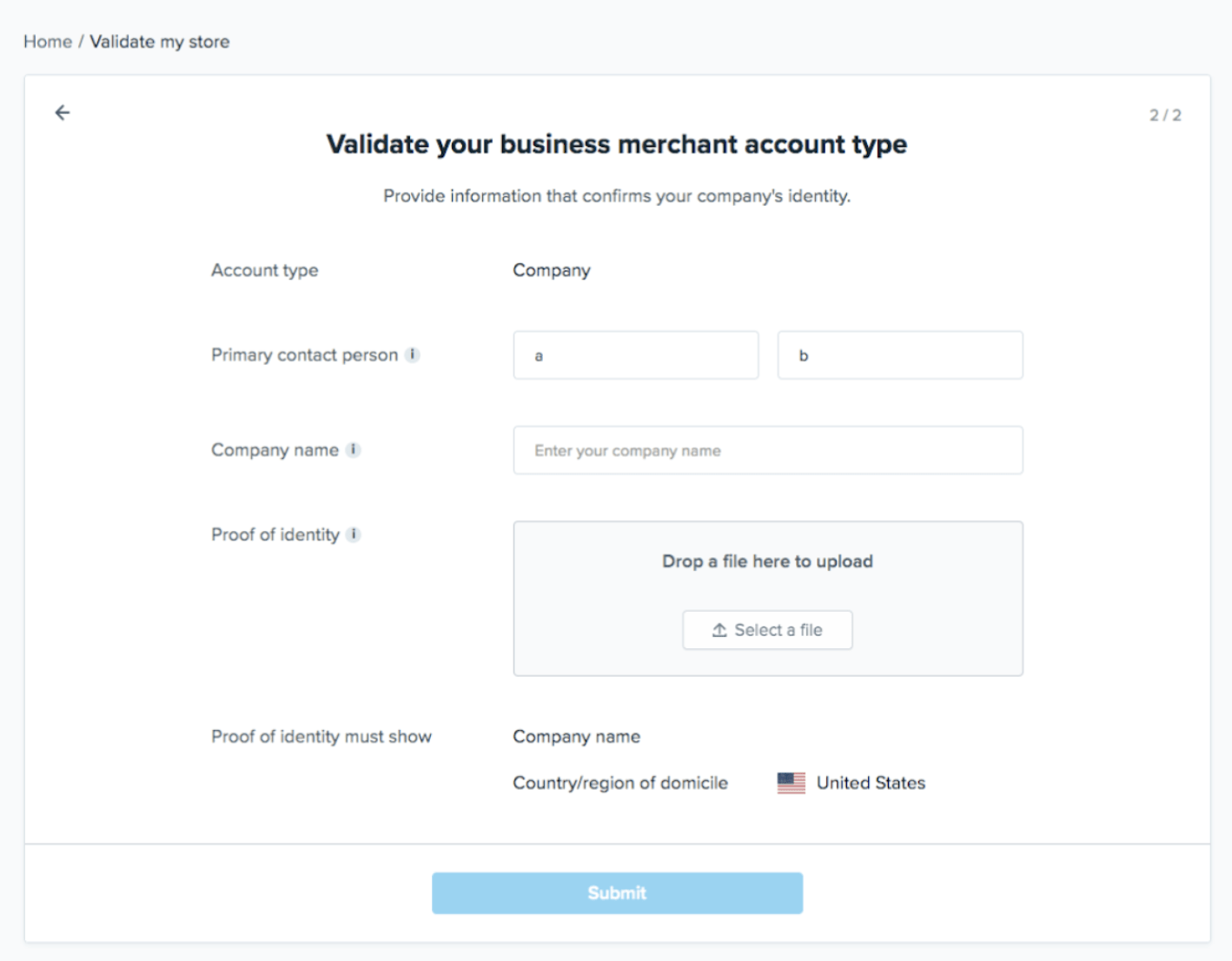
Lastly, click “Submit.”
Wish will then process and review your request within two business days. To view your validation’s status, navigate to your Seller Profile. Your status will be marked as “Validated” if successful, and you can start listing and selling your items.
If unsuccessful, however, your status will say “Rejected.” It’ll also show a list of your items that didn’t meet the criteria. You can try repeating the process by clicking “Validate store again.”
Wish seller fees
Wish takes a small commission or “revenue share” percentage that varies depending on the value of each transaction. It follows a tiered structure, but rates can range from 5% to 25% and is based on the following factors:
- Your Wish Express status
- The order’s destination and origin
- Your region of domicile or legal establishment
- The corresponding product’s category
For instance, a Wish Express order bound for Germany is subject to a 5% revenue share. On the other hand, a non-Wish Express order under the Household Supplies category that’s bound for the U.S. is subject to a 10% revenue share.
How revenue share is computed
Imagine you sold an item for $25 with $5 shipping and it’s subject to a 10% revenue share. Your total sale is worth $30 and its revenue share is $3. That means you’ll get paid $27 and Wish keeps the rest.
However, you can easily see the revenue share percentage per order in your Order details page on the Merchant Dashboard and via APIs.
How to lower your selling costs on Wish
Based on the above criteria that determines your revenue share percentage, you can take the following measures to lower your rates:
- Set up primary and secondary warehouses close to your intended selling destinations. This allows you to offer Wish Express shipping for more of your items.
- Establish business locations in regions where you want to sell.
- Sell in categories that have low marketplace referral fees.
Fulfillment options
With the sunset of Fulfillment by Wish, you’ll have two ways to fulfill your Wish orders: in-house or outsourced.
In-house
This option is ideal for businesses with an existing fulfillment or logistics infrastructure. You can fulfill your Wish orders yourself, but you’ll have to do it within the company’s service level agreements. If you’re unable to do so, the order will be refunded, Wish may disable the associated item, and you’ll be fined $50 for each auto-refunded order.
Outsourced
You can also choose to outsource your Wish order fulfillment to a third-party logistics (3PL) provider. This option is better for businesses who have or plan to have multiple sales channels. 3PLs are also more cost-effective for businesses without fulfillment or logistics in place.
Tips for sellers on Wish.com
Here are some best practices to help you succeed on the Wish platform.
Utilize shoppable videos
ContextLogic, the platform’s parent company, recently revealed Wish Clips. This is a new feature that allows you to create short videos demonstrating your products. It also links users to your store, their carts, or an option to purchase immediately.
Imagine you’re able to engage Wish users in a way that mimics livestream shopping, but potential customers are able to access it on demand. You can even feature partner influencers on your Wish Clips and have them demo your products to reach more audiences.
Advertise
Wish gives you access to its native advertising tool, ProductBoost. This feature increases your products’ exposure by moving them higher up the rankings than they typically would in organic searches.
Not only will it make your new products easier to discover, but it will also land your best products in front of more customers. Using ProductBoost doesn’t cost much either:
- Joining is free
- You only pay for impressions delivered
- You can set the budget for your campaigns
- The ad spend will never exceed your set budget
If you have newly uploaded products or items with low impressions, enabling IntenseBoost — which is a ProductBoost feature — is also ideal. It increases exposure over a shorter time frame, but at a higher spend. Once activated, Wish showcases your products in premium and highly visible locations in the Wish app and website.
Ship quickly
Setting your products’ max delivery days to five days or less makes it eligible for the Wish Express program. Offering this expedited shipping option qualifies your products for the following benefits:
- Increased impressions
- Quicker order payment eligibility
- An orange truck badge that highlights your fast-shipping products
- Appearance in a dedicated “Express” section of Wish
Qualify for Wish Standards
Wish Standards is a program that aims to reward high-performing merchants and improve the platform’s community of sellers and buyers. It also provides benefits that can improve your store’s visibility, revenue, and customer loyalty.
To qualify, you have to reach a minimum of 50 matured orders within 90 calendar days. Wish determines an order to be mature when enough time has passed for an accurate assessment of fulfillment status and customer satisfaction.
What’s more, based on user feedback, your compliance with Wish policies, and other metrics, Wish classifies your performance into one of four tiers (from Bronze to Platinum). You access better benefits at higher tiers (i.e., Gold and Platinum) such as:
- Impression boosts: Your products get ranking preference on Wish. Meanwhile, Bronze merchants may experience reduced impressions, and Silver merchants’ impressions may see little to no impact.
- “Premier merchant” badge and tag: This badge is visible to Wish customers. It alerts them that you offer superior customer service and product quality.

Wrapping up — Why and how to sell on Wish
Wish is a low-cost online marketplace, but potential and existing merchants may find the recent changes to sign-ups and order fulfillment options inconvenient. However, these developments boost the quality of buyers and sellers on the platform, which increases the likelihood of a sale.
Wish further makes up for its disruptive transitions through new programs and features that can significantly improve a merchant’s reach, customer loyalty, and performance, helping both the company and its sellers succeed.
